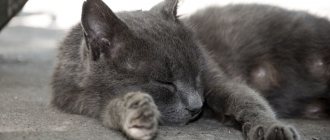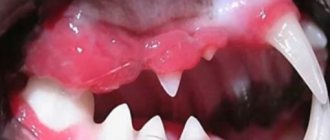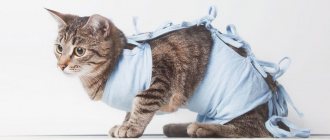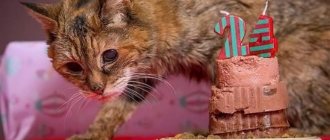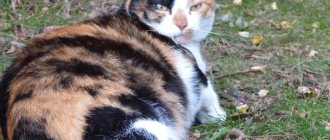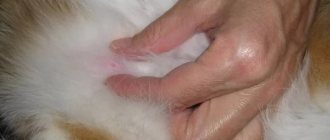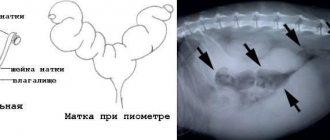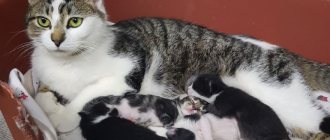Postpartum control
Look after your ward after giving birth.
Cats especially need supervision in the first two weeks. Take your temperature every day - the normal temperature for Sphynx cats is 39.4 degrees. An increase in temperature may indicate the onset of an inflammatory process due to the placenta not being delivered. Or the beginning of the development of mastitis or metritis. In any case, you should call a veterinarian. During the first week after giving birth, your cat will have reddish or dark green discharge. However, if the discharge has not stopped by the tenth day, this means that some kind of inflammatory process is going on in the uterus. If you notice such discharge by the 20th day, you should immediately call a veterinarian. Especially if the mucous membranes of the mouth and eyelids have turned pale, and the temperature is higher than normal.
General information about the duration of gestation
On average, the question “how long does a cat stay pregnant?” The most frequently heard answer is 2 months. However, this is a rather loose concept - some individuals barely carry their offspring to term for up to 60 days, and for some the process can last up to 70.
According to general estimates, the minimum gestation period for cats is from 56 to 60 days, the maximum normal is considered to be 71 days (some sources give 72 days). These are periods when the birth of viable offspring is allowed. Most often - 64-67 days (roughly rounded, it comes out to 9 weeks).
The entire “pregnant” period is conventionally divided into 3 phases of development, each of which on average includes 3 weeks.
1 phase
This period lasts from the moment of expected conception to 21 days. During this period, eggs are fertilized and embryos develop. By the 15th day, the embryo already becomes up to 1 cm in size, by the 18th day the paws appear, and by the end of the period the internal organs are already formed. It is in this phase that active pinking of the nipples is observed.
2 phase
During this period (from 22 to 42 days), the brain, skeletal structure, muscles and endocrine system are actively formed and developed. From this point on, the kittens are called fetuses, taking on the classic feline appearance with a clearly defined muzzle and genitals. Only after a month of pregnancy the cat’s belly begins to grow a little.
3 phase
On days 43-63 from the moment of conception, kittens, growing to 8-10 cm, acquire a tail and acquire a coat with a certain color. By the middle of the period, their size reaches 13 cm, by the 57th day they are already fully formed and developed babies who are ready to be born at any moment. The maximum size of a newborn depends on the constitution of its parents.
There are exceptions to all rules. The duration may vary depending on many factors:
- offspring of purebred individuals born before 60 days are most often non-viable;
- cats with a slender constitution (subtle) usually never go pregnant longer than 65 days (on average it is 60-65 days), and fat and well-fed ones usually carry a pregnancy and the period can reach 70-72 days;
- primiparous cats, especially those who become pregnant during their first heat before the age of 1 year, in most cases give birth earlier than the expected average period (up to 60 days). Kittens are not always born viable and are often weak and small. That is why experienced breeders do not recommend mating a cat to produce offspring in the first heat and under the age of one year;
- primiparous middle-aged cats bear their offspring somewhat longer than their female peers who have given birth;
- yard outbred cats bear less fruit than domestic and special breed cats. Sometimes healthy babies are born on the 55th day - this indicates better endurance and higher adaptability of street individuals compared to domestic ones;
- in a fold cat (British, Scottish), kittens are gestated for an average of 63-67 days, but almost never less than 60 days;
- cases of nursing up to 75 days have been recorded. The course of the entire period was without complications, and the newborns were all alive and well. The reasons for such a long but safe gestation are still a mystery to veterinarians;
- Pregnancy of the Maine Coon breed is usually longer than that of other breeds - up to 68 days or 9 full weeks + preparation for the birth of the cat herself;
- long-haired cats stay pregnant longer (up to 70 days) than smooth-haired or completely hairless cats (around 65 days);
- the fewer fruits there are in the litter, the longer the cat can go pregnant and, conversely, the more, the faster and more often the birth will occur before the due date;
- weather conditions affect the onset of labor - sudden changes in temperature and environmental humidity can suddenly trigger premature birth;
- The pregnancy of a Scottish cat is usually shorter than that of a British cat, in which the pregnancy period can sometimes increase to 70-72 days. Therefore, there is no clear answer to the questions of how long pregnancy lasts in a Scottish cat or how long pregnancy lasts in a British cat - variations in duration are present here too.
Maximum delay in labor
When more than 9 weeks have passed and delivery has not happened, the process is called delayed labor.
If the date of conception is known, the veterinarian begins counting down the days, telling the owner how many months the pregnant cat has been walking. It is not recommended to wait more than 1 week from now. Otherwise, the fetuses may experience hypoxia, which disrupts their development. Cubs may be stillborn.
Important! If all reasonable deadlines have passed, the doctor may prescribe medications that will stimulate the labor process.
In this case, he will be able to give birth independently after the onset of the drug and the first symptoms of labor.
Dietary features of sphinxes
Hairless cats (Canadian and Don Sphynx, Peterbald) have an accelerated metabolism. Fast metabolic processes are necessary to maintain normal body temperature. Because of this, sphinxes have an excellent appetite.
Most often, cats are not capricious; they eat whatever the owner offers. Pets do not refuse prohibited foods and leftover human food.
However, Sphynx cats have a sensitive digestive system, so the owner must carefully monitor the cat's diet. Any deviations in nutrition are fraught with diarrhea, dysbiosis and other health problems.
Peterbald, Canadian and Don Sphynxes are fed the same. These cats are physiologically very close.
Sphynxes cannot be suddenly transferred from one type of food to another. While ordinary cats need about a week to adapt to a new menu, these breeds take at least a month to make the transition.
False and frozen pregnancy
False pregnancy in sphinxes occurs when:
- hormonal disorders;
- intercourse with a neutered cat;
- stress exposure;
- mental disorder;
- disease of the reproductive system.
A falsely pregnant cat is fed low-calorie food and given medications that normalize hormonal synthesis. As a last resort, the Sphinx is sterilized.
Frozen pregnancy is observed in sphinxes when:
- hormonal disorder;
- inflammatory process;
- genetic abnormalities;
- stress;
- injury or pathological changes in internal organs.
If the ultrasound showed that some embryos survived, then the female sphinx is left pregnant. Dead babies come out during birth, just like live ones. If all the embryos have died, then they either wait for a miscarriage or use stimulation of the birth process.
How long does pregnancy last in cats?
The normal duration of pregnancy in cats is 60-72 days, that is, approximately 2 calendar months. If kittens are born before the specified date, they will be weak. Pregnancy lasting longer than 72 days poses a risk to the cat's health.
The due date is easy to determine if the mating was planned. Fertilization occurs after 1-1.5 days, so the estimated duration of pregnancy is calculated starting from the next day after the cat meets the cat. However, there may be a discrepancy of 2-3 days.
The timing of birth depends on many factors. These include:
- Age. The older the cat gets, the longer the gestation period lasts. As you age, your metabolism slows down, so embryos take longer to form and develop.
- Number of kittens. Childbirth will occur a little earlier if the litter is multiple.
- Emotional condition. Stress can cause pregnancy to prolong.
- Breed characteristics. Long-haired cats give birth later than short-haired cats. This is due to the characteristics of genetics. The gestation period for cats with long hair is 62-73 days, for cats with short hair it is 59-69 days.
The duration of gestation may depend on the breed. In British women, pregnancy lasts 63-70 days. Scottish cats give birth 62-69 days after conception. Persian cats live as cats for 63-68 days, Canadian Sphynx cats - 62-63 days.
The longest pregnancy period for Siamese is 65-72 days.
It should be borne in mind that the relationship between the duration of gestation of kittens and breed membership has not been scientifically proven. A more significant role is played by the individual characteristics of the organism. In any case, each birth in a cat is individual; the duration of pregnancy will vary for the same individual.
Caring for a pregnant animal
During pregnancy, limit your cat from jumping high. Due to the shifted center of gravity, it may fall. Do not forget about nutritious and proper nutrition during this period. Be sure to include vegetables, meat, and dairy products in your pregnant cat’s diet. If an animal eats dry food, it must be of very good quality.
A pregnant cat needs to be fed 4-5 times a day
Here are the main rules for feeding a pregnant cat:
- starting from the second period, increase the daily norm by 1.5-2 times;
- feed the cat 4-5 times a day;
- Make sure your diet has enough protein, vitamins and calcium;
- when feeding naturally, give your cat enough meat (half the daily requirement);
- do not forget to give the animal vitamins (if she eats natural food);
- dry food must be at least super-premium class.
A pregnant animal should have clean water freely available, especially if the cat eats commercial food. Do not let your pet go outside; she may choose a place to give birth outside the home.
What not to feed the Sphynx
Sphynx cats should not be fed the following foods:
- Fatty meat and lard - the cat’s body is poorly adapted to digest fatty foods.
- Sausages and smoked meats contain artificial additives that are harmful to animal health.
- Tubular bones - easily split, injure the esophagus and stomach.
- River fish - contains many small bones. The pet may choke.
- Fried foods are difficult to digest and cause indigestion.
- Sweets, baked goods, and baked goods disrupt the natural course of metabolic processes and increase the production of skin secretions.
- Potatoes, tomatoes, legumes - cause bloating and are practically not digestible.
- Mushrooms are not a natural food for cats. Their bodies lack enzymes to process such food.
- Citrus fruits, grapes, raisins, avocados, persimmons are toxic to cats and cause allergies.
- Onions and garlic - destroy red blood cells, causing hemolytic anemia.
- Rhubarb - due to the high concentration of oxalic acid, the Sphynx's kidneys may fail.
- Chocolate, cocoa - depress cardiac activity, cause vomiting and diarrhea.
Cats should not be given alcohol, coffee or other drinks containing stimulants.
False and frozen pregnancy
False pregnancy in sphinxes occurs when:
- hormonal disorders;
- intercourse with a neutered cat;
- stress exposure;
- mental disorder;
- disease of the reproductive system.
A falsely pregnant cat is fed low-calorie food and given medications that normalize hormonal synthesis. As a last resort, the Sphinx is sterilized.
Frozen pregnancy is observed in sphinxes when:
- hormonal disorder;
- inflammatory process;
- genetic abnormalities;
- stress;
- injury or pathological changes in internal organs.
If the ultrasound showed that some embryos survived, then the female sphinx is left pregnant. Dead babies come out during birth, just like live ones. If all the embryos have died, then they either wait for a miscarriage or use stimulation of the birth process.
Puberty
Female Sphynx cats reach sexual maturity quite early: already in the sixth or seventh month of life. It is during this period that your pet goes into heat for the first time in her life, during which the female emits loud cries, rolls on the floor and arches her back, at the same time stamping on the spot with her hind legs. In addition, during the period of estrus, the female’s manner of movement may change, as well as some other transformations, both in her behavior and character.
Puberty does not coincide with physiological
Moreover, while some Sphynx cats become extremely aggressive during this period, others undergo diametrically opposed metamorphoses and become extremely affectionate. Owners of Canadian Sphynx cats should remember one rule: it is strictly forbidden to breed a cat during its first heat, since it occurs during the period when its body is still developing.
The terms physical maturation and puberty should not be confused. These are completely different concepts, for this reason, at this stage of life, veterinarians prohibit mating Sphynx cats. This period is most suitable for the owner to carefully consider the details of the upcoming estrus and plan the choice of a partner for mating.
Cats' behavior can change noticeably during estrus.
As for sexual maturity in males, it occurs noticeably later than in females, and more specifically, somewhere around the seventh or eighth month. However, despite puberty, mating during this period is not advisable, since at this age your pet is absolutely not ready for it. When your cat reaches puberty, he will become much more aggressive and may begin to mark his territory and try to use soft things to satisfy his sexual needs.
How many kittens can a cat have in her lifetime?
Cats are characterized by high fertility; on average, from 3 to 8 kittens can be born in one litter.
How many babies can a cat have in her lifetime?
Over the course of her entire life, one female can give birth to up to 200 cubs. The record holder for the number of offspring was the outbred tortoiseshell cat Dusty from America, who gave birth to 420 kittens.
Modern medical technologies allow the owner to control the number and frequency of cat pregnancies, as well as facilitate the birth process. The main thing to remember is that the health of the pet and future offspring depends entirely on a balanced diet, conditions of detention and care.
What you need to prepare for the birth of kittens
The owner must first prepare the place where the cat will give birth. It must be clean, eliminating the presence of debris, dust, and any contaminants. If a person is not confident in his abilities, it is better to consult a veterinarian. Some clinics offer a function to call a doctor at home at the time of birth, even if it is at night.
If the owner decides to carry out the process independently, the following items are prepared for delivery:
- bandages, cotton wool, napkins, which must be sterile;
- diapers with high absorbency;
- large diapers, sheets, which are pre-washed, ironed, cut into small rags;
- sterile surgical gloves, several pairs;
- waffle towel;
- scissors, surgical thread for tying the umbilical cord, during labor, place in a glass for sterilization;
- a syringe designed for suctioning liquid;
- pen and paper to record the moment of birth of all cubs;
- scales;
- sterilizing liquids, for example, brilliant green, manganese, hydrogen peroxide;
- antibacterial agents;
- disposable syringes;
- ammonia if the kitten is weak and cannot recover;
- disposable waste collection bags.
The owner may not need the entire set of tools, but it is worth preparing for all cases.
The danger of cheap feed
It is not recommended to purchase food in bulk at the grocery store. Usually, this is how they sell cheap feed mixtures that will not bring any health benefits. Chemicals and dyes found in cheap pet food cause serious illnesses, including esophageal cancer. Manufacturers indicate the presence of chemical preservatives on the labels, so before purchasing the mixture you should carefully study the composition.
Manufacturers use the term “offal” to hide waste from the meat processing industry. At best, it will be skins and cartilage, and at worst, crushed bones. If the manufacturer indicates that the food consists of by-products, it is better to refuse to purchase it. This dish does not provide any nutritional value.
Pets may happily consume such food, but this does not mean that they understand its composition. Cats are well versed in natural meat and fish, but they do not understand anything about the chemical additives that manufacturers specifically include in low-grade products. Due to odor and taste enhancers, the dish attracts animals. They are deceived by the delicate aroma of chicken or turkey, and in return they receive a mixture that is far from meat in origin.
Therefore, if you decide to feed your pet a commercially produced formula, you need to carefully study the composition. It should contain meat or fish, but not offal.
What to feed a pregnant cat and how to organize meals
During pregnancy, the body needs more nutrients. This applies not only to a quantitative increase in food (due to the volume of portions), but also to a qualitative change in nutrition.
The nutritional features of a pregnant cat are as follows:
- Greater protein intake. If 20% of the total protein is enough for an adult pet, then this will not be enough for a pregnant cat. The optimal dose is considered to be 35–40%. If there is a protein deficiency, the fetus will not be able to grow normally or gain muscle mass, which is why the baby will be born weak.
- More vitamin D and phosphorus. These components are needed to ensure the development and normal condition of the skeletal system.
- Increased calorie content. The pregnancy period is characterized by an increase in energy expenditure, which is compensated by calories. This is achieved by increasing the serving size or more frequent feeding.
- Sufficient volume of liquid. This is especially true when using dry food for pregnant cats.
- Greater intake of animal fats such as Omega-3, Omega-6. This will have a positive effect not only on the health of the expectant mother, but also on the development of the kittens’ central nervous system.
In this video, a veterinarian will tell you how to properly care for a pregnant cat, what diet you should follow, and how to provide proper postpartum care.
The diet must meet all the special needs of the cat during pregnancy. It is recommended to feed her the following foods:
- Meat. The meat component should be the basis of the menu, which will provide the body with a sufficient amount of protein. It could be chicken, beef, turkey. Sometimes you can give offal (liver, heart). It is better to boil the meat or pre-freeze it to avoid the risk of infection. Completely eliminate sausages and sausages from your diet.
- Dairy products. Food for pregnant cats must contain sufficient amounts of calcium and vitamin D. A lot of calcium is found in milk and fermented milk products. Every day the cat is given cottage cheese, low-fat sour cream, yogurt, fermented baked milk, and kefir. Milk should be given only if the pet tolerates it well (no indigestion or diarrhea). Hard or soft cheese is offered less often.
- Vegetables. They are given both raw and boiled. In addition, vegetables contain fiber, which has a positive effect on the digestion process. Use cabbage, carrots, and beets for feeding.
- Fish. https://wikicat.ru/pitanie/kak-priuchit-kotenka-k-suhomu-kormu-2050/ Give your cat boiled fish without bones, about 1-2 times a week.
- Eggs. Eggs are a source of protein and fat. They are included in the menu several times a week (1-2 times).
During pregnancy, it is not recommended to switch to a different type of diet or try new foods. All products must be fresh and of high quality.
If a cat eats dry food, it should be at least premium. Even if she previously ate an economy-class product, it is better to switch her to a higher-quality analogue during pregnancy.
Be sure to make sure your cat drinks enough fluids. A bowl of clean water should be available at all times. Even if your pet does not drink water, it still needs to be replaced with fresh water.
If a pet in an “interesting situation” is naturally fed, she may need to take special food supplements (vitamin complexes and minerals). This is discussed individually with your veterinarian.
For a cat, it is important not only what it is fed, but also how it is fed. The organization of nutrition during pregnancy needs to be slightly changed
If previously it was enough to feed your pet 2-3 times a day, now meals should be done more often:
- up to 3 weeks – 4–5 times;
- at 4–7 weeks – 6–7 times;
- from 7 weeks until birth - about 5-6 times.
However, the serving size should not increase. On the contrary, the longer the gestation period, the smaller the size of a single (not daily) portion should be. This is due to the fact that the volume of the stomach decreases due to the pressure of the uterus.
Also, when organizing the diet, you need to carefully monitor the condition of the animal. If any changes occur, the diet must be adjusted. For example, if your cat is constipated, add more fiber and fermented milk products to the diet. If the expectant mother is worried about indigestion or diarrhea, increase her rice intake. This will not only relieve diarrhea, but will also help remove toxins.
Preparing for the event
Sphynx pregnancy lasts about two months - from 60 to 70 days. During this time, you should get used to the idea of expanding your family and prepare for the event. There is no need to worry about the process itself. As a rule, females cope with everything themselves. Sphynx cats have very well developed maternal instincts, so if the cat is healthy and has not had any problems during pregnancy, trust her. But there are points that you should take care of.
Location requirements
Cats are independent creatures and love to spend time alone and in silence. And during the birth process, cats generally have a special mental state, so they need peace and privacy. It would be better if it was a separate, quiet room. But you can select a secluded corner and put a special cat house in it or build it from a large cardboard box.
The best option is if it opens from the top, but has a small hole on the side so that the cat can get out to eat and go to the toilet. This hole should be located at such a height that small kittens cannot then accidentally crawl out of the box. You need to lay something soft inside to make it warm and comfortable. But cover it with disposable diapers (can be purchased at any pharmacy or children's store). These diapers are very soft, absorb moisture well and are easy to change.
As soon as you notice that the pet has begun to worry, look for a secluded place and drag soft things there, place it in the house and stay with it, gently talking and stroking it. This way the animal will calm down and understand that there is no need to look for a place anymore.
Materials and tools
Usually cats cope with everything themselves: they help the kitten to appear, lick it, and gnaw the umbilical cord. But you must be ready to join the process at any time and help your pet. Especially if she is giving birth for the first time.
Something else interesting: How to help a cat give birth when there is no doctor nearby
So, you will need:
- sterile medical gloves, which can be purchased at any pharmacy;
- sterile thread, disinfectant, scissors. You will need these tools if you need to cut the umbilical cord;
- small pipette or syringe: for sucking liquid from the nasal and oral cavity;
- clean soft napkins or pieces of cloth;
- Vaseline oil;
- artificial food: it is better to purchase a special one for cats, but as a last resort, for the first time you can get by with high-quality children’s food;
- if you want to monitor whether the baby is developing correctly, then scales, paper and a pen to record the weight;
- colorful ribbons: used to mark kittens. It is very convenient when artificial feeding or when there are a lot of babies, they help make sure that everyone eats.
In addition, it is better to make arrangements in advance with the veterinarian who cares for your cat in case of unforeseen situations.
First mating
The first mating for Canadian Sphynxes should be organized only after your pet is at least one and a half years old. At the same time, the cat will be completely ready for mating only after two, or even better, three heats. As for cats, the ideal age for the first mating is one and a half to two years, since only at this age the animal’s body has already formed. It should be noted that care should be taken to ensure that by this age both male and female cats have already received all the necessary vaccinations. Please note that under no circumstances should animals be vaccinated two weeks before mating.
Features of the first mating
The first meeting of a cat and a male cat does not always end in pregnancy. There are many reasons for this - from banal fear (you have to get used to your partner) to loud scandals and, oddly enough, incompatibility. The female may become aggressive if she does not feel safe, is hungry, or is extremely agitated.
We suggest you read: Allergies to sphinxes, hairless cats. Allergy to the Canadian Sphynx, Don Sphynx
But aggression at the time of mating or after pregnancy is only one, perhaps the most striking sign of changes in the life of a pet. Let's look at other possible signs.
Attitude to food
A female Sphynx can dramatically change her taste preferences. For example, I am happy to eat egg yolk or cottage cheese instead of meat products. Even a short-term refusal of semi-finished products (dry food, etc.) is possible.
Of course, if your pet lives on food produced by well-known brands and consumes little organic food, sooner or later he will return to his usual diet. No need to worry about this
But it is important to keep in mind that the diet of a pregnant cat should be adjusted depending on individual characteristics and the advice of a veterinarian
In practice, a pregnant Sphynx often eats more than usual because it is necessary to feed the embryonic offspring. A categorical refusal to eat is also possible, but it is isolated and not long-term. As a rule, after giving birth, the cat will return to its usual diet.
Lifestyle
It's easier at this point
Even hyperactive animals tame their agility and pay great attention to arranging their favorite sleeping place and their own safety. Any contact and encroachment on the sleeping area can lead to aggression
A loving owner should pay special attention, understand the difficult situation of the pet and help arrange the future “nest”. Of course, this is true for city cats that live in apartments
Freedom-loving inhabitants of private and country houses, as a rule, go to attics, bathhouses or barns to give birth. These are the strange cat ideas about comfort and safety.
External changes
20-25 days after the fateful meeting with the cat, a pregnant Sphynx can be recognized by external signs. The color of the nipples becomes milky and they rise slightly. The nipples will fill with milk a little later, around the sixth week. The cat is gaining weight.
From 30-35 morning toxicosis and general lethargy of the Sphinx are observed.
The most effective way is palpation of the abdominal cavity. But for inexperienced breeders this can be a real challenge, so it is recommended to turn to specialists.
During the first heat, it is advisable to isolate a teenage cat from contact with the opposite sex. This must be monitored especially carefully if she has free access to the street, which most often happens in private houses. Before the body is fully formed, any pregnancy should be excluded.
Representatives of some breeds are bred for the first time at one and a half years old. Before this, you need to show the cat to the veterinarian. It will determine how mature the pet’s body is to bear healthy offspring. It may be necessary to compensate for the lack of vitamins and microelements before the impending pregnancy. All necessary vaccinations must be completed.
Daily ration
The question of the daily diet is quite complex and does not have a universal answer in the form of a ready-made diagram. The amount of food a cat eats per day is influenced by several factors:
- breed of animal (and dimensions associated with the breed);
- age of the animal;
- number of embryos;
- gestational age;
- specificity of metabolic processes;
- type of feeding (natural and dry food require different dosages).
The amount of food in a pregnant cat's bowl is calculated individually
If you do not take into account the specific trimester, and outline the daily diet of an average-sized pregnant cat (weighing 3-4 kilograms), it will consist of the following items:
- meat (beef, chicken, turkey) – about 160-170 grams;
- fermented milk products (kefir, yogurt, yogurt) – about 50 grams;
- green grass - from 60 to 80 grams;
- chicken eggs (yolk only) – one egg every one and a half weeks;
- sea fish (boiled only) – one serving per week.
In purebred cats, pregnancy may be more difficult than in domestic cats.
It is believed that it is most difficult to select a diet for purebred cats, such as British, Scottish or Persian. However, no matter how purebred your pet is, it is one way or another recommended to show it to a veterinarian so that he can examine the animal and, if necessary, prescribe additional vitamin complexes. You can read about vitamins suitable for both pregnant cats and kittens below.
Vitamins for cats and kittens
Process Features
The process itself consists of three stages:
Contraction of the uterus: the vagina opens, minor discharge (mucus plug) and contractions may occur. Contractions become more frequent and stronger. The cervix is completely open and the fetus begins to move through the birth canal. Due to the pressure on the cervix, the cat strains to push the baby out as quickly as possible. The kitten may be born in a bladder if it does not rupture during birth. As a rule, the cat bursts the bubble itself and licks the kitten completely to open its airways and stimulate breathing. Variably, this can take from 10 minutes to an hour. If the stage has begun, more than an hour has passed, and the baby has not appeared, call the veterinarian. After the baby is born, the placenta comes out. After the cat licks the kitten and makes sure that everything is fine with him, she gnaws the umbilical cord and eats the placenta
At this stage, it is important to ensure that the placenta appears after each baby; if it gets stuck in the birth canal, this can lead to a dangerous infection. To be completely sure, if you are alone at the birth, it is better to write it down.
After the mother has taken care of the baby, she will push him towards the nipple. If this does not happen, you can apply it to the baby’s nipple yourself. Childbirth resumes. In between, the cat licks itself and rests. There are times when the process seems to be completed, and then after a few hours it resumes again.
Signs of imminent labor
An experienced breeder determines the imminent onset of labor within a few days. This makes it possible to prepare for the process and make it as smooth as possible. The pregnancy of the Canadian Sphynx and the upcoming birth leave an imprint on the appearance and behavior of the animal:
- the mammary glands swell and colostrum oozes from them;
- the cat often licks its genitals;
- the animal may lose its appetite;
- the nose and ears become cold, the overall body temperature decreases;
- a pregnant pet is looking for a secluded corner where she tries to hide in order to build a place for herself to give birth;
- if the expectant mother accepted the place offered by the owner, she often climbs into it;
- From time to time the sphinx shows restlessness - it follows its owner, meows, rubs against its legs and demands attention.
Immediately before the onset of labor, the animal's breathing becomes intermittent. The cat can lie on its side with its hind legs extended. The most reliable sign is the release of amniotic fluid and the appearance of contractions.
When the kitten is born, the female licks it and bites through the fetal membrane, freeing first the head of the cub and then the body. Then the mother independently gnaws the kitten's umbilical cord and eats the afterbirth. She needs this, since the placenta contains a large amount of hormones and other biologically active substances that are beneficial for the cat.
When do you need veterinary help?
In most cases, the cat copes with the birth of kittens on her own. But there are times when the help of a loving owner is extremely necessary. Sometimes, due to fatigue and pain, a cat can “squeeze” a cub that is only halfway out. Most often, this happens if the kitten walks forward with its hind legs.
Such situations require immediate intervention. The easiest way to help is to grab the cat by the scruff of the neck so that it stands upright on its hind legs.
By switching to a new stimulus, the woman in labor will relax the vaginal muscles and the kitten will be born. If this does not help, then more radical measures should be taken. You need to carefully take the kitten with a gauze cloth (a clean cloth or a gynecological glove) and pull it out with light, rocking movements. This should be done at those moments when the cat begins to struggle.
Normal birth in British cats does not require specialist intervention. However, owners should observe how the cat behaves after giving birth. If certain symptoms occur, you should immediately call your nearest veterinary clinic.
We suggest you read: Fleas on a cat - how to identify and get rid of them
• labor does not begin more than 70 days after conception;
• there are signs of fever and increased temperature in cats before giving birth;
• fever in cats after birth;
• the appearance of bright red discharge from the vagina, lasting more than 10 minutes;
• unpleasant and pungent odor from the vagina;
• contractions in cats without continuation of labor for a long time (more than an hour);
• restless behavior of the cat after the termination of labor.
When you need help
There are situations in which the cat cannot or does not have time to cope on its own (short interval between births). Therefore, you should be alert if:
- The release of amniotic fluid and the birth of the baby coincided. You must make sure that the baby does not choke: turn him upside down and shake him lightly. If he sneezed or sighed, everything is fine;
- the cat did not have time to free the kitten from the bubble. Tear it, carefully wipe the baby with a soft napkin or cloth, use a syringe or pipette to clean the nasal and oral cavities;
- the cat did not chew the umbilical cord. To avoid blood loss, tie the umbilical cord with a thread and cut it with scissors. Everything must be sterile;
- if the kitten is too weak and does not breathe normally. Perform very lightly (with gentle finger pressure) cardiac massage and artificial respiration;
- if the movement of the fetus is difficult or stuck. Lubricate your vagina with Vaseline oil. Make a loop from a soft napkin or cloth and slowly help pull the baby out while pushing;
- weak contractions. Consult your veterinarian and get a stimulation shot;
- In any unclear situation, call your doctor.
Proper care for a pregnant cat
The interesting position of the pet will require changes in care from the owner:
- Nutrition. Provide your pregnant cat with proteins and calcium: - if the cat eats a certain food, it should not be changed. It is better to purchase food “for a pregnant cat” or “for kittens” under the same brand. In this case, additional vitamins are not needed to avoid hypervitaminosis; - if the cat eats natural food, you should choose foods rich in protein: meat, eggs, milk. Make sure that the cat eats more, especially in the first weeks of pregnancy.
- Keep your pet at home.
On the street, out of habit, a cat can climb a tree or explore narrow holes, which is extremely dangerous in its position.
In addition, labor cannot be allowed to begin on the street.
Care and nutrition
A pregnant Sphynx requires special nutrition . Cat food should be selected based on its age and individual condition. The diet should contain more foods rich in protein and calcium. You can purchase special food for pregnant women or for kittens.
It is also necessary to care more carefully - at this time the cat requires more attention. It is better to avoid walking outside at this time. If you don’t take care of your pet, repeated fertilization is possible, which will not benefit the cat’s health and will harm future offspring.
All medications that a cat takes during pregnancy must be approved by a veterinarian . This is especially true for anthelmintic, insecticidal and acaricidal drugs.
During pregnancy, immediately after lambing, the animal especially needs its own housing. You can build a cozy nest for a cat. It is better to place it in a warm, quiet place without drafts. A pregnant pet's house should be low enough so that she does not have to make sudden movements or jump from great heights. This can lead to injury to the offspring. To save the expectant mother from additional stress, it is advisable to protect her from other animals at this time. The cat may behave aggressively, and it will end in a fight, which is completely undesirable during pregnancy.
What to feed a Sphynx kitten
Now that we've looked at the best food for an adult cat, let's talk about hairless kittens. Little sphinxes are extremely active, inquisitive and playful. They require more energy for normal development than babies of other breeds in order to warm their body unprotected by fur.
The first complementary foods are introduced into the kitten’s diet at the age of 1 month. It could be semolina porridge or egg yolk.
When the kittens are 2 months old, ground boiled beef or chicken breast and calcined cottage cheese are introduced into the diet. You can occasionally give cheese as a treat - sphinxes love it.
Until the baby is 3 months old, the frequency of feeding him should be 6 times a day - 25 grams of food per meal. From the same age, boiled and raw meat, herbs, vegetables and fruits are allowed. Particularly active kittens need eight feedings. A six-month-old kitten eats less - the number of feedings is reduced to 2-3 times a day, 40-50 grams.
More information about the diet of kittens here.
An older kitten can be fed with ready-made industrial food of the “holistic”, “premium” and “super-premium” classes. Their composition is completely balanced and adapted for actively growing sphinxes. It is best to choose special brands - for kittens:
- Royal Canin Babycat Instinctive – mousse for kittens up to 4 months;
- Royal Canin Kitten – dry food for kittens from 4 to 12 months;
- Purina Pro Plan Junior Chicken – canned food for kittens with chicken;
- Wahre Liebe “Junge” – dry food for kittens with colostrum;
- Hills Cat Science Plan Kitten Tuna – dry food for kittens with tuna;
- GO! Sensitivity + Shine Duck Cat Recipe Limited Ingredient Diet, Grain Free – for kittens and cats with sensitive digestion.
Diet
Due to the fact that these cats have active heat exchange, they have an excellent appetite, they do not know moderation in food. Pets chew everything they come across on the way. This should under no circumstances be allowed, since overeating and poor quality food lead to the development of urolithiasis. Eating meat in large quantities leads to protein poisoning. Frequent and abundant feeding causes obesity.
Malnutrition is also undesirable, since with such a diet problems with the gastrointestinal tract can develop.
Feeding the Sphynx involves some rules. Every owner should know the main ones:
- portioned food;
- strict diet;
- lack of access to toxic substances or plants that a cat can try out of curiosity;
- Contact your veterinarian if you lose your appetite.
The Sphynx is given larger portions than other breeds. Due to the lack of fur, he is much more active and therefore loses energy. You need to feed the kitten 6 to 8 times a day. A serving should be 25 grams. As they grow older, the number of feedings should be reduced to 2-3 times, and portions increased to 50 grams.
The Sphynx's diet should resemble a children's menu. A kitten that is one month old should receive formula, porridge, yolk and milk. At the age of 2 months, he needs to add cottage cheese, cheese, and lean meat to the menu.
We suggest you read: How to determine the breed of a cat or kitten: online identification by cat color
At 3 months, the diet becomes more varied and includes both boiled and raw meat. You can also give your pet fresh vegetables and fruits.
It is better to give preference to natural food. Animals need high-quality products to be healthy and active. This list should include:
- beef;
- chicken;
- cereals;
- greenery;
- fruits;
- vegetables;
- dairy products;
- cheeses.
Sometimes the owner may not have time to cook for his cat, but he needs to be fed. There is a way out - a simple recipe:
- Grind chicken breast or beef (1 kilogram) through a meat grinder.
- Grate 150 grams of cheese.
- Grind 2 small carrots and greens through a meat grinder.
- Add 1 chicken egg yolk and 5 chalk tablets to the mixture.
- Add 20 drops of vitamin D and 1 tablespoon of brewer's yeast to this.
- Make balls or cutlets from the resulting mixture and freeze. This food can be thawed as needed and given to the cat. This way your pet will receive adequate nutrition and essential nutrients.
If you want to feed your animal with ready-made food, then you need to choose only a high-quality premium product. Cheap store-bought food will be harmful to the cat's health, since it only temporarily gives a feeling of fullness, but has absolutely no benefit.
The Sphinx needs organized, proper care, adequate nutrition and care. This is the only way to raise a healthy pet that will live for many years and will treat its owner with gratitude. Sphynx cats are incomparable to anyone else. They are so good-natured and affectionate that their owner will never regret taking such a friend.
It’s worth noting right away that the nutrition of hairless cats has a number of features. This is due to increased energy exchange and high heat transfer, that is, nutrition must correspond to rapid metabolism. It is recommended to feed the Sphinx 3-4 times a day in small portions. Be sure to follow the feeding regime.
Don Sphynxes can be fed natural food or ready-made food. The choice is always up to the owner.
If the cat is not picky, then you can choose a convenient diet and cook the food yourself. The basis of natural nutrition is meat, some porridge and vegetables; sometimes fermented milk products; once a week fish and raw quail egg. Vitamin and mineral supplements must be given in courses.
But if the Donetsk dog is very picky and cannot be provided with adequate nutrition with natural products, then it is better to opt for ready-made dry food of premium class and higher. High-calorie diets for domestic active cats or food designed specifically for hairless breeds are best suited.
Many Sphynx cats are prone to overeating, which leads to excess weight gain. The diet of such pets must be closely monitored.
Feed replacement
Even the most expensive and elite food can cause digestive upset in a pet. Problems with bowel movements, diarrhea, constipation, and general deterioration in health indicate that the body does not accept the food offered.
The kitten becomes restless, refuses to play with the owner, and eats reluctantly. It is necessary to contact a veterinarian and have the animal examined. If no objective reasons have been identified, then the deterioration of the condition is caused by poor nutrition. In this case, it is necessary to change the food.
The change in diet is approached gradually. Choose another feed manufacturer. Add some new ones to the old granules and offer them to the kitten. Sphynxes are very sensitive to substitution and at first they can sort out their food, choosing the usual one.
The replacement process is lengthy; if the cat categorically refuses to eat the new food, it is necessary to purchase another one. This is how the trial method is used to achieve a complete replacement of nutrition. You need to be patient, because the health of the pet is in the hands of the owner.
Signs of the onset of labor in a cat
If you are patient and closely monitor your pregnant cat, you may know that labor is approaching a week or two before it begins. It is important to notice in time that your pet is soon going to become a mother, in order to prepare everything necessary for the kittens, provide assistance during childbirth, and not miss possible complications.
A week or two before giving birth, the cat begins to worry and look for a secluded place, so the owner better take care of a nest for the mother and cubs if he does not want the pet to nest in the closet with linen or in a hard-to-reach place, for example, under the bathtub. Also at this time, she often licks her belly, becomes irritable or, on the contrary, very affectionate, constantly demanding attention. There may be decreased appetite and frequent urination. The cat's belly noticeably droops downwards, and does not stick out from the sides, as before.
When there are only a few days left before the kittens are born, the expectant mother becomes nervous, meows often, scrapes the litter with her paws, and refuses to eat. If the animal is not aggressive, you can begin preparing for childbirth by trimming the hair around the nipples and under the tail.
If a cat is attached to its owners, it can constantly follow them, demanding that they follow it to the place it has chosen for giving birth. At this time, the cat’s body temperature decreases by a degree to one and a half, and rises again just before giving birth. If you look closely at the calmly lying pet, you can notice the movement of the kittens in the mother’s stomach - the future babies are moving in the uterus, preparing for birth. From this moment on, it is better for the owner not to leave his pet unattended. It is advisable by this time to prepare everything necessary for assistance during childbirth and write down the phone number of the veterinary clinic where it can be easily found if necessary.
On the eve of giving birth, the cat almost does not leave her shelter, the nipples on her stomach swell
Source
What is breeding or mating of dogs?
Mating is the procedure of mating dogs of breeding value in order to obtain a high-breed litter.
According to the regulations on breeding work of the Russian (and International) Cynological Federation, mating of bitches is permissible once a year - through estrus. A one-time exception can be made for animals, breeds that are on the verge of extinction or for females of special breeding value. Provided that the bitch receives restoration in the next year. There are no restrictions for males; males can be mated at least every month.
Individuals that have breeding value, are completely healthy and have reached the age of 18 months are allowed to mate. For bitches, as a rule, this is the third estrus. The breeding value is determined by a breeding expert at the exhibition. For a male dog, admission to breeding is considered to be no lower than “very good”; for a female dog, no lower than “good”. Some breeds also require a mental health test.
Important
https://youtube.com/watch?v=VRQA6SLQfmo
Features of animal behavior
During sexual heat, the behavior of dogs changes to varying degrees, depending on the individual characteristics of the body.
The first estrus in bitches occurs at 5–7 months in small breeds and 6–10 months in large breeds. Behavior changes only during the period of estrus, after which it returns to normal:
- The female actively leaves marks on the street.
- May become more irritable and restless, and show aggression towards other females.
- There are interruptions in appetite.
- The dog can mount others, including females.
Males mature by about 7 months, changes in behavior are possible:
- The dog actively begins to mark its territory.
- It is possible to display aggression towards other males and a protective instinct.
- Interest in females increases.
- Attempts to mount other dogs, including males, are possible.
- The dog refuses to follow commands and is stubborn.
Among other things, the release of testosterone at the sight of a female in heat drives a male dog crazy - the pet does not hear or see the owner at this moment, does not respond to commands, and there are frequent cases of running away after females in heat.
When can and should you adopt pets?
Estrus occurs twice a year in most females, and once a year in some native breeds. The average duration of estrus is 21 – 28 days, depending on the breed and individual characteristics of the body. The ovulation period, a favorable time for mating, lasts from 2 to 5 days. The male is ready for insemination all year round.
Ovulation occurs on the 8th – 14th day of estrus; it is on these days that you need to go on a “date with your gentleman”. Until the female is ready to mate, she will not allow the male to approach her. But if the dog is far away, in order not to travel in vain, you need to determine the exact day of readiness for mating; this can be done at a veterinary clinic or you can try it yourself.
Symptoms of ovulation in a bitch:
- When pressing on the croup, the dog stands and moves its tail to the side.
- The loop becomes soft and increases in size.
- Vulvar discharge becomes paler.
- If you press on the loop, it rises up and the tail goes to the side.
Progesterone in dogs for mating (table)
Testing for progesterone in dogs is done through a blood test. Not all veterinary institutions perform this procedure, so you can go to a human hospital for research. Based on the results obtained, we can conclude that the bitch is ready for mating.
Details in the table:
| ng/ml | nmol | What to do |
| Less than 1 | Less than 6 | Repeat the analysis on the fourth day |
| 2 – 4 | 6 – 12 | Repeat the analysis in a day or two |
| 5 – 7 | 5 – 22 | The beginning of ovulation. Mating is fruitful for another three days. |
| 8 – 11 | 24 – 33 | Mating must be carried out on this day and the next day |
| 11 – 19 | 34 – 60 | Mating is carried out on this day and throughout the day |
| Over 19 | More than 60 | Immediate mating. Take a maximum of 12 hours. |
In what situations do you need help?
If the owner of a purebred cat is not sure that he can cope with the birth process on his own, you need to invite a veterinarian.
In force majeure circumstances, the woman in labor will have to help herself. This happens during a rapid birth: the kittens come one after another, and the mother does not have time to cope with them. An example situation: the cat has not finished licking the first one, the second kitten has already appeared, and attempts are being made on the third.
Assistant actions:
- quickly and carefully free the newborn from the membrane of the amniotic sac, slightly cutting it;
- using a sterile napkin, release the kitten from the shell;
- wipe him, at this moment he should begin to breathe;
- if the kitten is not breathing, you should turn it head down and shake it slightly;
- if this also does not help, you need to suck out the liquid from the spout using a pipette and do a light massage of the chest - rhythmically press on the heart area;
- Place the kitten close to the mother's nipple and help her latch on to it.
The cat did not have time to gnaw the umbilical cord:
- Tie the cord tightly with a clean thread at a distance of 1–2 cm from the kitten’s belly;
- cut the umbilical cord with scissors from the placenta side;
- remove the placenta.
The fetus came out partially, got stuck in the birth canal - the sphinx does not have enough strength to push. In this situation, you need to act as follows:
- lubricate the vulva around the fetus with Vaseline oil;
- Carefully grab the kitten using a napkin;
- wait for the next push, then lightly pull and help him come out;
- place the newborn next to the mother.
Normally, childbirth in sphinxes lasts from 4–5 hours to a day. The completion of labor is indicated by the behavior of the cat. She begins her own hygiene after licking the kittens.
To maintain your cat's strength, you can give her warmed milk with yolk.

